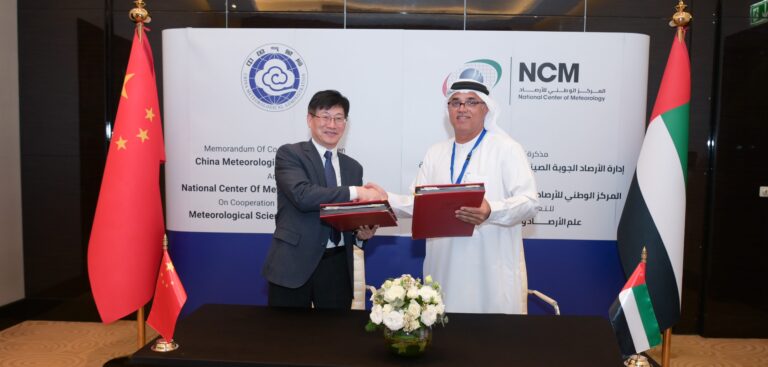The UAE’s National Center of Meteorology (NCM) has signed a memorandum of cooperation with the China Meteorological Administration (CMA) to promote collaboration in the field of meteorological science and technology, and reduce the loss caused by meteorological disasters to society and the economy.
The scope of cooperation includes areas such as weather modification technology; FengYun Meteorological Satellite monitoring and remote-sensing applications; weather forecast and exchange of meteorological information; and technical exchanges on meteorological telecommunications.
The memorandum was signed at a special ceremony held on the sidelines of the Regional Conference (RECO) of WMO’s Regional Association II (Asia), hosted by NCM in Abu Dhabi, UAE.
Dr Abdulla Al Mandous, director general of NCM and president of the Regional Association II (Asia), said, “We are delighted to sign this memorandum of cooperation with the CMA, which marks a significant milestone toward strengthening our cooperation in the field of meteorology. This agreement will allow us to share expertise and best practices and to work together toward enhancing the capabilities of our human capital in latest technologies in meteorological observation and forecasting. Such collaborations align with NCM’s priority to deliver better weather forecasting and meteorological services for the benefit of our communities.”
Li Jian, engineer-in-chief, CMA, said, “The cooperation between China and the UAE in the field of meteorology has tremendous potential to yield positive outcomes for both sides, especially in the areas of meteorological services, weather forecasting and disaster management. The signing of this agreement today demonstrates our shared commitment to developing more robust and resilient meteorological system in both China and the UAE, while promoting innovation and collaboration to stay abreast with the latest advancements in meteorological research and technologies.”
The memorandum also covers cooperation in areas of climate monitoring, prediction and research on climate change; meteorological observation and instrumentation; and AI technology in meteorology, among others.
Both sides also agreed to carry forward the mechanism of cooperation by exchanging visits of staff and experts; coopering in scientific research or experimental program; jointly organizing seminars, workshops and lectures; and encouraging other areas of cooperation agreed through consultation between both sides.



